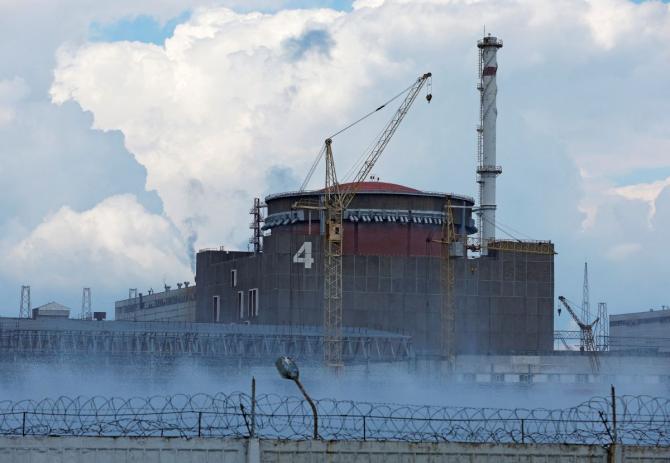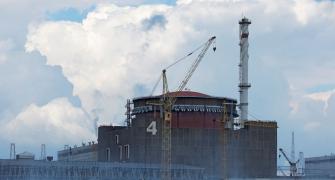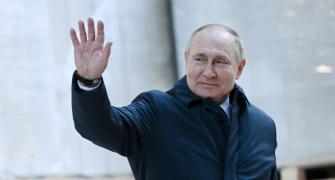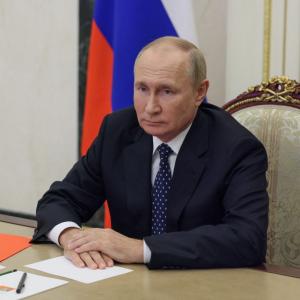With the fight now having been taken to the seizure of nuclear plants, it is one more warning to Europe that this prolonged war could end up with disastrous consequences, observes Rashme Sehgal

Europe has been drawn into a spiralling conflict between Russia and Ukraine which once again throws up the fears of it escalating into a nuclear conflict.
The eye of the storm remains Europe's largest nuclear facility, the Zaporizhzhia Nuclear Power Plant (ZNPP) located on the river Dnieper.
The Russian troops seized the plant in March 2022 and despite several warnings issued by International Atomic Energy Agency (IAEA) Director General Rafael Grossi in the last 28 months, the Russians have proceeded to turn the ZNPP into an impregnable fortress.
The plant has been caught in the crossfire with both sides attacking it and blaming the other side for damages caused to it.
With the Ukrainian forces stationed across the river, the Russian forces are facing continuous firing.
Most recently a drone attack by the Ukrainian forces caused a fire in the ZNPP leading Grossi to state that the situation at the plant is 'very fragile'.
The drone attack had damaged a cooling tower causing a fire from which black smoke billowed through the weekend.
Fortunately, the fire has been extinguished and since all six reactors had been shut down earlier, the IAEA officials did not detect any spike in radiation levels.
Though one of the IAEA observers stationed there did admit that he had 'witnessed strong dark smoke coming from ZNPP's northern area following multiple explosions heard in the evening.'

Grossi's warnings that such 'reckless attacks are increasing the risk of a nuclear accident 'cannot be underestimated.
Professor Meshkati Najmedin, an expert on nuclear safety at University of Southern California, is much more forthright in his comments on the unfolding situation.
He believes the situation in ZPPP is very dire pointing out that the drone attack had caused a major fire at the cooling tower plant causing water levels in the plant to fall substantially.
The situation is further compounded because these regular attacks affect the electricity supply.
The plant has suffered eight losses of off-site power since the seizure, forcing it to rely temporarily on emergency diesel generators, and it continues to face challenges related to staffing.
Professor Najmedin further pointed out that the few Ukrainians staff manning ZPPP 'were already under stress and so any error can lead to a catastrophe'.
His reference is to the fact that Ukraine's Energoatom, which operates all of the country's nuclear power plants, has repeatedly said Russia restricted qualified Ukrainian staffers from working at ZPPP after they refused to become Russian citizens.
Most of the Ukrainian staffers were replaced by Russian workers who Energoatom officials claim do not know how to run the plant. This claim seems farfetched because many of the plants in Ukraine were set up by Russian technocrats.

AT ZPP, the spent fuel pools are stored in cooling pools inside the reactor containers but this is not the case with the dry cask storage areas.
These contain radioactive waste which are located outside the containment area and these could get hit and crack open due to the bombardment. This would release radioactive material into the atmosphere.
The example of Fukushima is before the world when on March 11, 2011 a massive tsunami affected the electricity supply and damaged the backup generators at the Fukushima Daichi plant.
Although all three of the reactors that were operating were successfully shut down, the loss of power caused cooling systems to fail caused the residual heat within the reactor's core to melt the fuel rods, leading to a release of radiation.
Professor Najmedin makes no bones that his biggest worry is the dry cask storage areas outside containment building.
'My biggest fear is if attacked by missile or an aerial bombardment can lead to dry casks opening, they may release radioactive material,' Professor Najmedin said.
The risk at ZPP is very high as it needs a continuous flow of electricity to run the cooling pumps.

From May, the situation has further deteriorated. Ukraine has stepped up attacks on Russia.
Its drones damaged a radar in the southern Krasnodar region while another targeted a similar facility in the southern Urals, about 1,500 kms from the border;
Both are part of Russia's early warning system to spot intercontinental ballistic missile launches thousands of kms away.
Both Moscow and Washington rely on such systems to track each other's launches.
The Ukrainian raids on Russian nuclear-capable bomber bases could qualify as triggers for atomic weapons use under Moscow's nuclear doctrine. Russian hawks urged the Kremlin to respond forcefully.
Hawks have urged that the time has come for Moscow to revise its nuclear strike doctrine and declare that Russia could use nuclear weapons first when its core national interests are at stake.
With the West allowing Ukraine to hit Russian territory, Putin threatened to respond by providing weapons to Western adversaries worldwide.
He underscored the message in June by signing a mutual defence pact with North Korea, signalling Moscow could start arms deliveries to Pyongyang.
Meanwhile the Ukraine army has recently launched a counter attack in the Kursk region of Russia with Ukrainian forces having blown up three crucial bridges.
Defence experts believe this military incursion into Kursk is being done to create a buffer zone that can be used as a bargaining tool as and when peace talks between the two nations resume.
But other experts believe that the ultimate objective of the Ukrainian army is to seize the Kursk Nuclear Power Plant (KNPP) as payback for Russia's long-running seizure of Ukraine's Zaporizhzhia nuclear plant.
Some experts quote unofficial sources to claim that Ukrainian troops can be seen just 23 km from the KNPP.
This is an extremely disturbing development. The KPPP is just 60 km from the Ukrainian border but unlike ZPPP, its reactors, each with a capacity of 1,000 MW, are similar to those used Chernobyl.
These do not have domes (concrete containment structures) and so are more liable to be damaged by external threats. They are more vulnerable to artillery and missile attacks.

Russia began the tactical nuclear weapons manoeuvres announced at the beginning of May.
The first phase of the exercise, taking place in the south of the country near the border to Ukraine, includes the preparation and use of non-strategic nuclear weapons.
Such exercises are taking place for the first time since Russia's invasion of Ukraine. These began one day before President Putin began his fifth term in office.
Russia has started tactical manoeuvres of both its nuclear and non-nuclear air defence and naval missile units.
Putin has repeatedly warned of nuclear war if NATO troops are sent to Ukraine. Tactical nuclear weapons include nuclear warheads for ground-to-air missile systems with a range of up to 500 kms, and also sea- or air-based missile systems.
There are no signs of peace returning to this region. Analysts believe that while there are no clear figure of the number of casualties, Russia, they believe has lost over 500,000 soldiers while Ukraine would have suffered equally large figures though the figure put out by Ukraine indicates around 50,000 casualties.
They allude to increased year-over-year defence spending of NATO allies, including an estimated 13 percent increase on global nuclear weapons to a record $91.4 billion in 2023, according to the International Campaign to Abolish Nuclear Weapons.
That equates to a $10.7 billion increase in spending on nuclear weapons in 2023 compared to 2022, led by the US funding 80 percent of that increase.
NATO Secretary General Jens Stoltenberg has told the media that the spending of NATO countries on weaponry has risen substantially.

Dr R Rajaraman, emeritus professor of physics at the JNU, in the course of an interview disapproves of these extreme statements being made by right wing hawks.
'There is little chance of Putin hitting the nuclear button... He is not going to frighten anyone in the West with these statements. I do not think he is planning a nuclear war. His military would not allow him to do so. Even if he is in a mad state like Hitler, his generals would not permit it. He is egotistical, but not to this extent,' Dr Rajaraman said.
'There is plenty of resentment within Russia opposing his invasion of Ukraine. A nuclear war is something else.
'If he were to drop even one nuclear weapon in Europe, it would start a nuclear war that would destroy everybody,' said Dr Rajaraman.
Other scientists are not so sure. The longer the war in Eastern Europe continues between Russia and Ukraine and the increasing use of advanced weaponry combined with a worsening situation in West Asia, apprehensions are being expressed that this could develop into a world-wide conflict.
In January, the Bulletin of the Atomic Scientists' Science and Security Board reset the Doomsday Clock to keep it at 90 seconds to midnight as a clear warning that the world remains a mere step away from global catastrophe.
With the fight now having been taken to the seizure of nuclear plants, it is one more warning to Europe that this prolonged war could end up with disastrous consequences.
Feature Presentation: Rajesh Alva/Rediff.com









